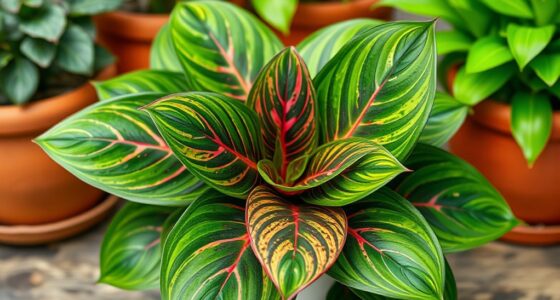To keep your fiddle leaf fig thriving, avoid overwatering and check soil moisture regularly—water only when the top inch is dry. Make certain your plant has good airflow and proper drainage to prevent root rot, a common issue many overlook. Watch for pests and address problems early to prevent damage. Consistent care, seasonal adjustments, and awareness of subtle signs will boost your plant’s health. Continue exploring tips that ensure your fig stays happy and vibrant.
Key Takeaways
- Proper watering is crucial; check soil moisture and avoid overwatering to prevent root rot.
- Ensure good airflow and maintain optimal humidity to reduce pest risks and promote healthy growth.
- Regularly inspect undersides of leaves for pests like spider mites and treat promptly with neem oil or insecticidal soap.
- Adjust watering frequency seasonally, watering thoroughly every 7-10 days in warmer months and less in cooler months.
- Healthy roots depend on proper drainage, consistent moisture, and early pest detection to keep your Fiddle Leaf Fig thriving.

Are you struggling to keep your fiddle leaf fig healthy and thriving? If so, you’re not alone. This popular houseplant can be finicky, but understanding its basic needs can make all the difference. One of the most essential aspects is establishing a proper watering schedule. Unlike many plants, fiddle leaf figs dislike overwatering, which can lead to root rot, but they also need consistent moisture to stay healthy. The key is to check the top inch of soil—if it feels dry, it’s time to water. When you do, give your plant a thorough soak until water drains from the bottom, then empty the saucer to prevent sitting water. During the growing season, typically spring and summer, you might need to water every 7 to 10 days. In cooler months, reduce watering frequency to prevent excess moisture that can cause issues. Developing a routine based on your home’s humidity, temperature, and the plant’s specific environment helps prevent stress and keeps your fiddle leaf fig looking its best. Additionally, understanding the plant’s root health and avoiding overwatering are crucial for avoiding common problems like root rot.
Pest management plays a key role in maintaining a healthy fiddle leaf fig. Common pests like spider mites, mealybugs, and scale insects can quickly attack if left unchecked. Regularly inspecting your plant is essential, especially on the undersides of leaves and along the stems. If you notice tiny webs, cottony spots, or sticky residue, it’s time to act. Use a gentle insecticidal soap or neem oil, and thoroughly wipe down affected areas to remove pests. Isolating new plants before introducing them to your main collection can prevent the spread of pests. Prevention is better than cure, so maintaining good airflow and avoiding overwatering reduces the likelihood of pest infestations, which thrive in moist, stagnant environments. Address issues promptly to avoid damage to your plant’s leaves and overall health.
Frequently Asked Questions
How Often Should I Rotate My Fiddle Leaf Fig for Even Growth?
For even growth, you should rotate your fiddle leaf fig every 1-2 weeks. This helps guarantee all sides receive equal light exposure, preventing uneven growth. Regular rotation also encourages a balanced watering schedule, as the plant’s roots grow uniformly. Keep an eye on how the light hits your plant, and adjust the rotation frequency if you notice uneven development, maintaining ideal health and symmetry.
Can I Propagate My Fiddle Leaf Fig From a Leaf Cutting?
Think of your fiddle leaf fig as a treasure chest, waiting to reveal its secrets through leaf cutting. While propagation techniques often focus on stem cuttings, you can sometimes try leaf cuttings, but success isn’t guaranteed. It’s like planting a seed of hope. Carefully cut healthy leaves, let them callus, and keep them in moist soil. Patience is key—nature’s magic takes time to turn leaf cuttings into new plants.
What Are Common Pests That Attack Fiddle Leaf Figs?
You should regularly inspect your fiddle leaf fig for common pests like spider mites, mealybugs, and scale insects. Pest prevention starts with consistent plant inspection, looking for tiny webs, sticky residue, or discolored spots. If you spot pests early, you can treat your plant with neem oil or insecticidal soap. Staying vigilant helps keep your fiddle leaf fig healthy and pest-free.
How Do I Prevent Leaf Drop During Winter Months?
Imagine your fiddle leaf fig sharing secrets to stay vibrant in winter. To prevent leaf drop, you should adjust your watering schedule, avoiding overwatering, and make certain proper humidity control. Keep the soil slightly moist but not soggy, and increase humidity with a humidifier or pebble tray. These gentle adjustments help your plant feel cozy and secure, reducing stress and keeping those beautiful leaves intact all season long.
Is It Okay to Prune My Fiddle Leaf Fig Regularly?
You can prune your fiddle leaf fig regularly to maintain its shape and promote healthy growth. Use proper pruning techniques like cutting just above a leaf node to encourage growth regulation and prevent overgrowth. Regular pruning helps remove dead or damaged leaves and shapes the plant, but avoid over-pruning, which can stress your plant. Consistent, gentle trimming keeps your fiddle leaf fig vibrant and thriving.
Conclusion
Just as you start to think you’ve got the fiddle leaf fig figured out, a sudden change in light or water reminds you how unpredictable these plants can be. It’s almost like they teach you patience and adaptability without even trying. So, keep observing, adjusting, and trusting the little signs. In the end, your plant’s resilience mirrors your own ability to grow through surprises—proving that sometimes, the most unexpected moments lead to the strongest survival stories.









